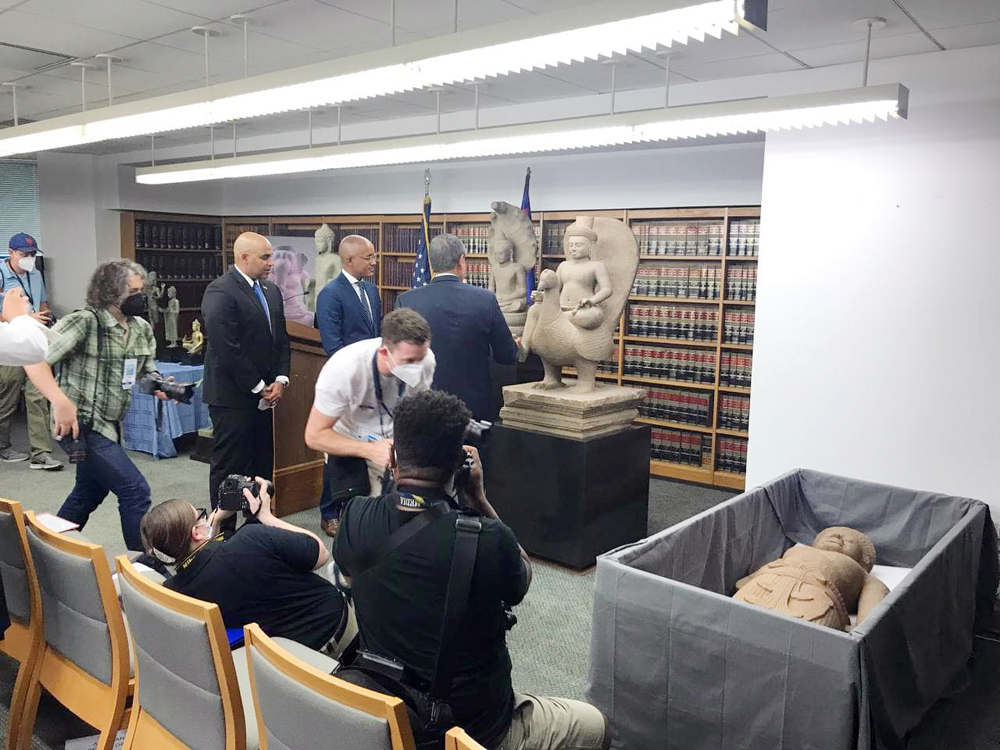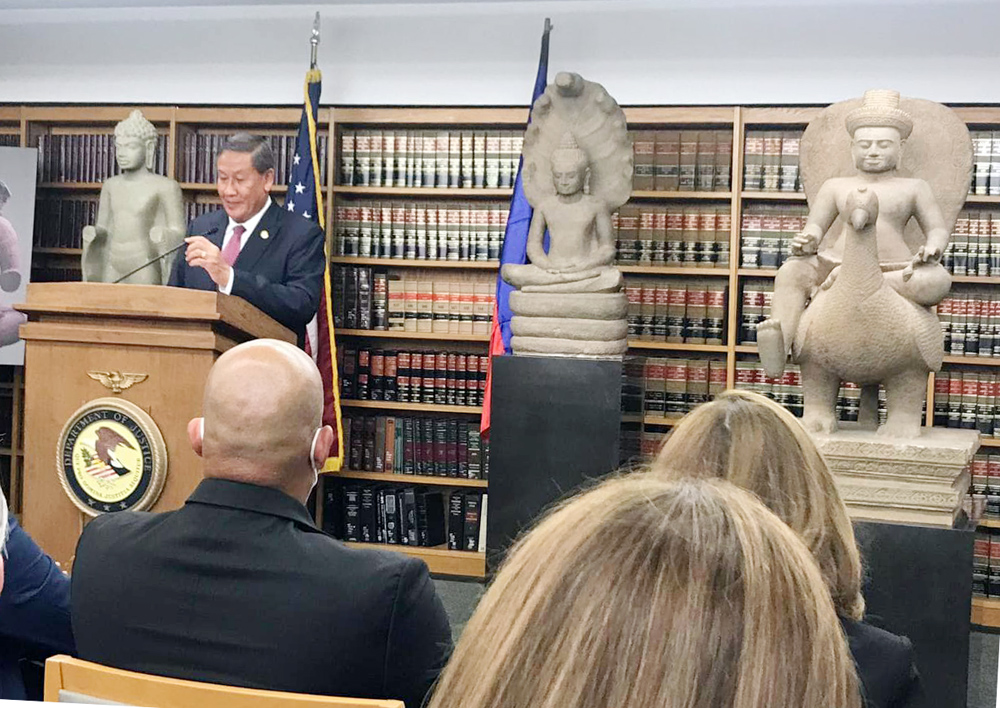New York — the United States Attorney announced 30 Cambodian statues and artifacts will be returned to Cambodia as a result of joint investigation with U.S. Homeland Security and the Cambodian government. The antiquities were stolen from Cambodia several decades ago as part of an organized looting network and sold by antiquities dealer Douglas Latchford.

Cambodian Ambassador to the United States Keo Chhea received the antiquities during a ceremony at the U.S. Attorney’s Office in New York on August 8, 2022. According to a press release by the Cambodia Ministry of culture and Fine Arts, which stated “there are several Buddhist and Hindu statues, such as the extraordinary sculptures of ‘Skanda on a Peacock’ and ‘Ganesha’ that were removed about two decades ago from temples at Koh Ker, the former royal capital of the Khmer Empire in the 10th century. Koh Ker was the target of widespread looting over a number of years during the war.”
U.S. Attorney Damian Williams said, “Today we celebrate the return of Cambodia’s cultural heritage to the Cambodian people, and reaffirm our commitment to reducing the illicit trafficking of art and antiquities. It is with great pleasure that we send the Skanda on a Peacock and the rest of these artworks on the final leg of their journey home.”
In 1970 when General Lon Nol removed King Sihanouk as head of state, the Vietnamese army launched an attack on Phnom Penh, which plunged Cambodia into war for the next two decades. Backed by communist countries, the Khmer Rouge defeated Lon Nol in 1975 and reigned for 4 years, only to be defeated in 1979 by a second Vietnamese invasion and occupation that lasted until the 1991 Paris Peace Agreements.
During two decades of war, Cambodian statues and other artifacts were stolen from Koh Ker and other archeological sites in Cambodia and entered the international art market through an organized looting network, according to a press release by U.S. Attorney Office. “Local teams of looters would first remove the statues from the original sites. The statues would then be transported to the Cambodia-Thailand border, and transferred to brokers, who would in turn transport them to Khmer artifacts dealers located in Thailand, particularly Bangkok. These dealers would sell the artifacts to local or international customers, who would either retain the pieces or sell them on the international art market.”
Bangkok-based antiquities dealer Douglas Latchford, a/k/a “Pakpong Kriangsak” sold the antiquities to individuals in the western art market, private collectors and museums. It’s hard to know much Latchford had sold over the years as he hired an offshore finance company to handle his trust, which his family claimed it was for tax and estate planning purpose, according to the pandorapapers report.
In 2019, Latchford was charged by the U.S. Attorney Office with wire fraud conspiracy and other crimes related to a multiple-year scheme to sell looted Cambodian antiquities on the international art market, primarily by creating false provenance documents and falsifying invoices and shipping documents. The indictment was ultimately dismissed after his death.
In February 2019, Latchford’s daughter, Nawapan Kriansak, formerly known as Julia Ellen Latchford Copleston, said the family relinquished her father’s $50 million collection of Khmer antiquities and will repatriate them to Cambodia. There were 125 pieces of ancient Cambodian art which are owned by private collectors. Some of the world’s renown museum such as the Metropolitan Museum of Art, the Denver Art Museum and the Cleveland Museum of Art have Cambodian antiquities from Latchford.
Ricky J. Patel, Acting Special Agent in charge of the Homeland Security Investigation in New York said, “these antiquities were ripped from their country…many are sacred artifacts pried from temples and palaces to be smuggled across borders and peddled by those seeking profit, without any regard to the intangible value they have to the people of their homeland. These artifacts belong to the people of Cambodia, and we are proud to participate in their recovery and their return home.”
The antiquities repatriated to Cambodia are sandstone and bronze sculptures and artifacts, ranging in age from the Bronze Age to the 12th Century, which were either removed illegally from Cambodia by looters, imported into the United States based on false statements to US Customs and Border Protection (“CBP”), or both.
Cambodian US Ambassador Keo Chhea praised the collaboration between the US and the Cambodian government to help the return of Khmer cultural heritage, and said they need to continue to fight to prevent more looting.
This article is available in Khmer.



